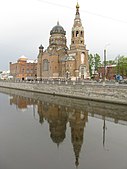Russian Revival architecture
Top: The Cathedral of Christ the Saviour from Moscow (original built 1839-1860, dynamited in 1931, rebuilt 1994-2000); Centre: The Igumnov House from Moscow (1883–1893); Bottom: The Timiryazev Museum from Moscow (1892-1905) | |
| Years active | Mid 19th-early 20th century |
|---|---|
The Russian Revival style (historiographical names are: Russian style,
The Russian Revival architecture arose within the framework that the renewed interest in the national architecture, which evolved in Europe in the 19th century, and it is an interpretation and stylization of the Russian architectural heritage. Sometimes, Russian Revival architecture is often erroneously called Russian or Old-Russian architecture, but the majority of Revival architects did not directly reproduce the old architectural tradition. Being instead a skilful stylization, the Russian Revival style was consecutively combined with other international styles, from the architectural romanticism of first half of the 19th century to the style moderne.
Cultural background
Like the Romantic revivals of
The attempt to discern the chronology and development of Russia's building begins in earnest with
-
Sts Peter and Paul's Cathedral in Petergof, Saint Petersburg
-
State Historical Museum in Moscow
-
Chernigovsky skete in Sergiyev Posad
Development
1825–1850

The first extant example of Byzantine Revival in Russian architecture and the first example ever built stands in
The
.Official enforcement of Byzantine architecture was, in fact, very limited: it applied only to new church construction and, to a lesser extent, to royal palaces. Private and public construction proceeded independently. Thon's own public buildings, like the pseudo-
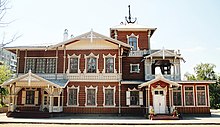
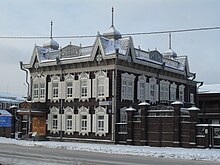
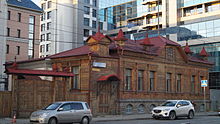
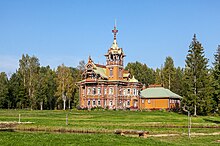
1850s
Another direction taken by the Russian Revival style was a reaction against official Thon art, influenced by Romanticism,
Post-1861
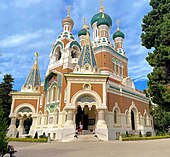
The
Ivan Zabelin, a theorist of the movement, declared that "Russian Khoromy, grown naturally from peasants' log cabins, retained the spirit of beautiful disorder... Beauty of a building is not in its proportions, but on the contrary, in the difference and independence of its parts" ("русские хоромы, выросшие органически из крестьянских клетей, естественно, сохраняли в своем составе облик красивого беспорядка... По понятиям древности первая красота здания заключалась не в соответствии частей, а напротив в их своеобразии, их разновидности и самостоятельности").[4] As a result, "ropetovschina", as Ropet's foes branded his style, concentrated on hoarding together vivid but not matching pieces of vernacular architecture, notably high-pitched roofs, barrel roofs and wood tracery. Wood was the preferred material, since many fantasies could not be physically built in masonry. This was good and bad for "dopetovschina". Bad, because wooden structures, especially those unconventionally shaped, were not scalable and had a very short life span. Very few survive to date. Good, because speed of construction and unorthodox looks were a perfect match for exhibition pavilions, coronation stands and similar short-term projects. The trend continued into 20th century (Fyodor Schechtel)[5] and 1920s (Ilya Golosov).[6]
For a short time in the 1880s, a less radical version of Pseudo-Russian style, based on copying 17th century brick architecture, almost succeeded as the new official art. These buildings were built, as a rule, from the brick or whitestone, with the application of modern construction technology they began to be abundantly decorated in the traditions of Russian popular architecture. The characteristic architectural elements of this time, such as "pot-bellied" columns, low arched ceilings, narrow window-loop holes, tented roofs, frescoes with floral designs, use of multicolored tiles and massive forging, are manifest both in the external and in the internal decoration of these structures. A typical example is the Historical Museum (1875–1881, architect Vladimir Sherwood) which completed the ensemble of Red Square.
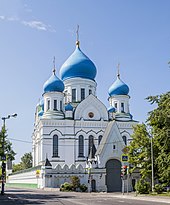
1898–1917
At the turn of the centuries, the
- DorogomilovoCathedral, Moscow, 1898–1910
- Our Lady of Iveron Cathedral in Nikolo-Perervinsky Monastery Cathedral, Pererva (now Moscow) 1904–1908
- Kronstadt Naval Cathedral, 1908–1913
1905–1917
- Fyodor Gornostaev, 1908–1913
- Balakovo church by Fyodor Schechtel, 1909–1912
- Emperor railway station in Pushkin town, 1912
- St.Nicholas church by Belorusskaya Zastava in Moscow, 1914–1921
Gallery
-
Odintsovo
-
Church of St.Basil of Caesarea
-
Cathedral of Christ the Saviour in Borky
-
Pavilion at the Triumfalnaya Square
-
Russian pavilion at the Exposition Universelle (1878)
-
Russian pavilion at the World's Columbian Exposition (1893)
-
Russian pavilion at the Exposition Universelle (1900)
-
Church of the Great Martyr and Healer Panteleimon in Udelnaya
-
The Nikonov building from Saint Petersburg
-
Central Bank branch, Oryol
-
Golovanov House, Tomsk
-
Moscow City Duma
-
Church of Archangel Michael
-
Head office of the State Bank of Russian Empire in Nizhny Novgorod
-
Epiphany Cathedral (1718), Irkutsk
-
Modern House "Теремок" in Moscow
-
Philharmonic building, Barnaul
-
Church of Alexander Nevsky, Chelyabinsk
-
Temple of Demetrius of Thessaloniki, Lipetsk Oblast
-
Church of Resurrection of Christ, Saint Petersburg
See also
- Neo-Byzantine architecture in the Russian Empire
- Russian neoclassical revival
- National Romantic style
- Postconstructivism
Footnotes
- ^ Russian: Власов, В.Г., "Большой энциклопедический словарь изобразительного искусства", 2000, ст."Русско-византийский стиль"
- ^ "Moscow. Monuments of Architecture, 18th - the first third of 19th century", Moscow, Iskusstvo, 1975, p.331
- ^ photo
- ^ Russian: Власов, В.Г., "Большой энциклопедический словарь изобразительного искусства", 2000, ст."Псевдо-русский стиль"
- ^ 1901 draft Archived 2002-09-04 at the Wayback Machine
- ^ 1923 draft Archived 2006-10-13 at the Wayback Machine
- ^ Russian: Елена Лебедева, "Храм Богоявления Господня в Дорогомилове", www.pravoslavie.ru Archived 2007-02-25 at the Wayback Machine








![Bell tower of the Epiphany Cathedral [ru] in Kazan, Tatarstan](http://upload.wikimedia.org/wikipedia/commons/thumb/0/0d/%D0%9A%D0%BE%D0%BB%D0%BE%D0%BA%D0%BE%D0%BB%D1%8C%D0%BD%D1%8F_3.jpg/180px-%D0%9A%D0%BE%D0%BB%D0%BE%D0%BA%D0%BE%D0%BB%D1%8C%D0%BD%D1%8F_3.jpg)




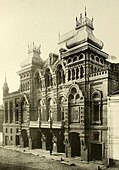

![Pokrov church [ru]](http://upload.wikimedia.org/wikipedia/commons/thumb/c/c7/%D0%A6%D0%B5%D1%80%D0%BA%D0%BE%D0%B2%D1%8C_%D0%BD%D0%B0_%D0%91%D0%BE%D1%80%D0%BE%D0%B2%D0%BE%D0%B9.jpg/170px-%D0%A6%D0%B5%D1%80%D0%BA%D0%BE%D0%B2%D1%8C_%D0%BD%D0%B0_%D0%91%D0%BE%D1%80%D0%BE%D0%B2%D0%BE%D0%B9.jpg)

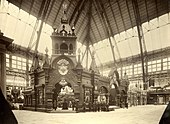
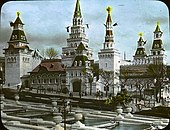



![Timiryazev Museum [ru]](http://upload.wikimedia.org/wikipedia/commons/thumb/3/33/Moscow%2C_Timiryazev_Museum_01.jpg/150px-Moscow%2C_Timiryazev_Museum_01.jpg)

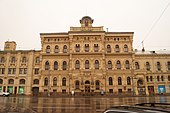



![Moscow Spiritual Consistorium [ru]](http://upload.wikimedia.org/wikipedia/commons/thumb/6/6f/%D0%94%D0%BE%D1%85%D0%BE%D0%B4%D0%BD%D1%8B%D0%B9_%D0%B4%D0%BE%D0%BC_%D0%9C%D0%BE%D1%81%D0%BA%D0%BE%D0%B2%D1%81%D0%BA%D0%BE%D0%B9_%D0%B4%D1%83%D1%85%D0%BE%D0%B2%D0%BD%D0%BE%D0%B9_%D0%BA%D0%BE%D0%BD%D1%81%D0%B8%D1%81%D1%82%D0%BE%D1%80%D0%B8%D0%B8_01.jpg/170px-%D0%94%D0%BE%D1%85%D0%BE%D0%B4%D0%BD%D1%8B%D0%B9_%D0%B4%D0%BE%D0%BC_%D0%9C%D0%BE%D1%81%D0%BA%D0%BE%D0%B2%D1%81%D0%BA%D0%BE%D0%B9_%D0%B4%D1%83%D1%85%D0%BE%D0%B2%D0%BD%D0%BE%D0%B9_%D0%BA%D0%BE%D0%BD%D1%81%D0%B8%D1%81%D1%82%D0%BE%D1%80%D0%B8%D0%B8_01.jpg)
![Maksim Gorky Samara Academic Drama Theatre [ru]](http://upload.wikimedia.org/wikipedia/commons/thumb/d/d4/Samara._Drama_Theatre_P8160481_2200.jpg/170px-Samara._Drama_Theatre_P8160481_2200.jpg)
![Shibaevs’ estate [ru]](http://upload.wikimedia.org/wikipedia/commons/thumb/1/1e/Moscow%2C_Novaya_Basmannaya_23-1_July_2015_03.JPG/170px-Moscow%2C_Novaya_Basmannaya_23-1_July_2015_03.JPG)

![Church of the Assumption [ru], Saint Petersburg](http://upload.wikimedia.org/wikipedia/commons/thumb/f/f0/Church_of_the_Dormition_SPB_01.jpg/170px-Church_of_the_Dormition_SPB_01.jpg)



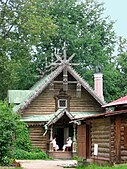

![Miansarova-Gutman house [ru]](http://upload.wikimedia.org/wikipedia/commons/thumb/d/d1/Meshchansky_District%2C_Moscow%2C_Russia_-_panoramio_%28198%29.jpg/170px-Meshchansky_District%2C_Moscow%2C_Russia_-_panoramio_%28198%29.jpg)




![Holy Cross Church in Darna [ru]](http://upload.wikimedia.org/wikipedia/commons/thumb/4/42/%D0%A6%D0%B5%D1%80%D0%BA%D0%BE%D0%B2%D1%8C_%D0%92%D0%BE%D0%B7%D0%B4%D0%B2%D0%B8%D0%B6%D0%B5%D0%BD%D0%B8%D1%8F_%D0%96%D0%B8%D0%B2%D0%BE%D1%82%D0%B2%D0%BE%D1%80%D1%8F%D1%89%D0%B5%D0%B3%D0%BE_%D0%9A%D1%80%D0%B5%D1%81%D1%82%D0%B0_%D0%93%D0%BE%D1%81%D0%BF%D0%BE%D0%B4%D0%BD%D1%8F.JPG/170px-%D0%A6%D0%B5%D1%80%D0%BA%D0%BE%D0%B2%D1%8C_%D0%92%D0%BE%D0%B7%D0%B4%D0%B2%D0%B8%D0%B6%D0%B5%D0%BD%D0%B8%D1%8F_%D0%96%D0%B8%D0%B2%D0%BE%D1%82%D0%B2%D0%BE%D1%80%D1%8F%D1%89%D0%B5%D0%B3%D0%BE_%D0%9A%D1%80%D0%B5%D1%81%D1%82%D0%B0_%D0%93%D0%BE%D1%81%D0%BF%D0%BE%D0%B4%D0%BD%D1%8F.JPG)







